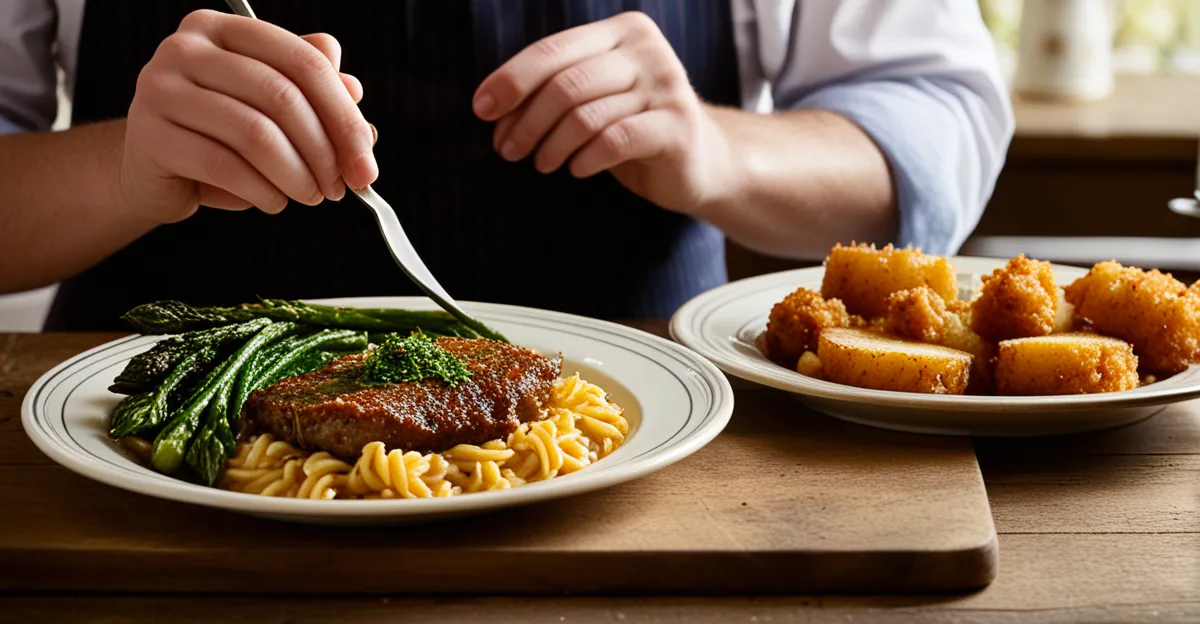Creative Approaches to Reinventing British Classics
Reimagining traditional British dishes demands a delicate balance between honoring culinary heritage and welcoming contemporary cuisine adaptation. Modernising classic recipes often involves tweaking cooking techniques or ingredient profiles without losing the dish’s soul. For example, chefs might introduce locally sourced herbs or swap richer fats for lighter alternatives to refresh flavor while preserving essence.
Popular adaptations include transforming the classic roast by incorporating unexpected seasonings or elevating pies with artisanal pastry dough. Another approach is crafting contemporary twists by blending textures or adding subtle spice, enhancing appeal to today’s palates. Maintaining authenticity amid current dietary trends means respecting foundational elements while innovating thoughtfully.
Additional reading : How can you prepare a classic bubble and squeak with leftover vegetables?
Experimentation with preparation methods, such as slow-cooking to intensify flavors combined with vibrant garnishes, showcases how British staples evolve elegantly. This creativity not only attracts modern diners but also ensures that traditional dishes remain relevant and celebrated. By embracing innovation with reverence, cooks can craft dishes that are simultaneously nostalgic and exciting—a true testament to the vibrancy of modern British cuisine.
Innovative Ingredient Substitutions for British Recipes
Modern twists on traditional British dishes often rely on clever ingredient swaps, allowing classic flavours to shine while accommodating new dietary needs. For example, vegan British food adaptations like shepherd’s pie use lentils or mushrooms instead of minced lamb, preserving the dish’s hearty texture and rich taste. This approach respects the original essence while broadening appeal.
Also to read : How can you achieve the perfect texture in a traditional spotted dick?
Gluten-free adaptations also play a crucial role in contemporary cuisine adaptation. Swapping out wheat-based pastry for gluten-free flours in pies maintains crispness and flavour, ensuring inclusivity without compromising quality. Additionally, incorporating lighter ingredients—such as oat milk or low-fat cream—can reduce the heaviness historically associated with some British classics.
Leveraging seasonal, local, and international produce introduces fresh dimensions to familiar plates. For instance, adding Mediterranean herbs to a traditional stew or using root vegetables native to Britain highlights both sustainability and flavour innovation. These ingredient swaps create engaging new experiences while upholding the spirit of beloved recipes, demonstrating how tradition and modernity can harmoniously coexist in British cooking.
Incorporating Fusion Flavours and Global Influences
British cuisine is evolving through fusion cuisine, blending traditional British dishes with global spices and cooking techniques. This approach to flavour innovation enriches dishes while respecting their roots. For instance, incorporating aromatic Indian spices into classic recipes creates bold, new taste profiles without overwhelming the original dish.
A popular example of fusion is the curry-infused fish and chips variant. This dish marries the beloved British staple with the vibrant flavours of South Asian cuisine, appealing to diverse palates and showcasing multicultural British food. Such combinations highlight how global influences can be thoughtfully integrated to enhance traditional meals.
The rationale behind adopting fusion elements lies in celebrating cultural diversity while expanding the culinary landscape. It invites both chefs and diners to explore exciting, contemporary cuisine adaptation that reflects modern Britain’s dynamic identity. By experimenting with ethnic ingredients and cooking methods, cooks preserve tradition and foster culinary creativity, ensuring British classics continue to evolve with the times.
Modern Presentation and Plating Techniques
Elevating traditional British dishes through modern food presentation is key to appealing to today’s diners. Contemporary cuisine adaptation often involves rethinking plating styles to highlight the dish’s core elements while adding visual interest. Instead of large, rustic servings, chefs now favour minimalistic touches and refined arrangements that emphasize balance and colour contrast, making flavours more inviting.
Examples include deconstructed components laid out artfully to showcase texture or layering sauces and garnishes with precision. Such updates not only enhance aesthetics but also offer a fresh dining experience without altering the familiar taste of beloved recipes. Smaller, elegant portions cater to current serving size trends, aligning with health-conscious dining while respecting traditional richness.
Chefs advise using seasonal herbs or edible flowers as garnish to add vibrancy and a hint of freshness. Additionally, thoughtful plate selection—often simple white or matte finishes—allows the food to be the star, reinforcing the dish’s identity. This careful redesign of presentation styles bridges heritage and innovation, proving that modern British cuisine aesthetics can celebrate the past while captivating contemporary palates.
Adapting to Health-Conscious and Dietary Preferences
Modern nutrition adaptations are essential in reinventing traditional British dishes to meet today’s health-conscious demands. Many classic recipes are known for their richness, often containing high levels of fats and sugars. To create healthy British food versions, chefs reduce these elements by using alternatives such as olive oil instead of butter and natural sweeteners like honey or maple syrup. This preserves familiar flavours while lightening the overall dish.
Dietary customisation also addresses allergen concerns and diverse diets. For example, gluten-free adaptations replace wheat-based ingredients with grains like quinoa or rice flour, maintaining texture and taste without gluten. Vegetarian and vegan options, featuring plant-based proteins and dairy-free creams, broaden accessibility seamlessly.
Ensuring nutritional balance without sacrificing tradition involves careful ingredient selection and portion control, allowing dishes to remain hearty yet suitable for everyday meals. This balancing act acknowledges the importance of flavour and cultural identity while embracing evolving dietary preferences in contemporary cuisine adaptation.
By updating these recipes thoughtfully, cooks can provide inclusive, nourishing options that respect heritage and satisfy modern nutritional expectations, encouraging wider enjoyment of beloved British cuisine.











